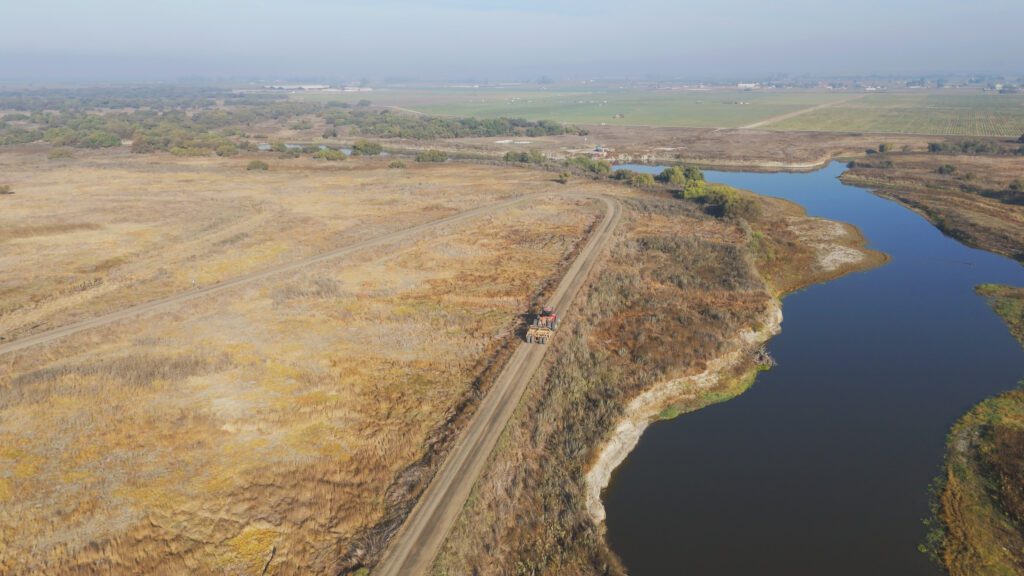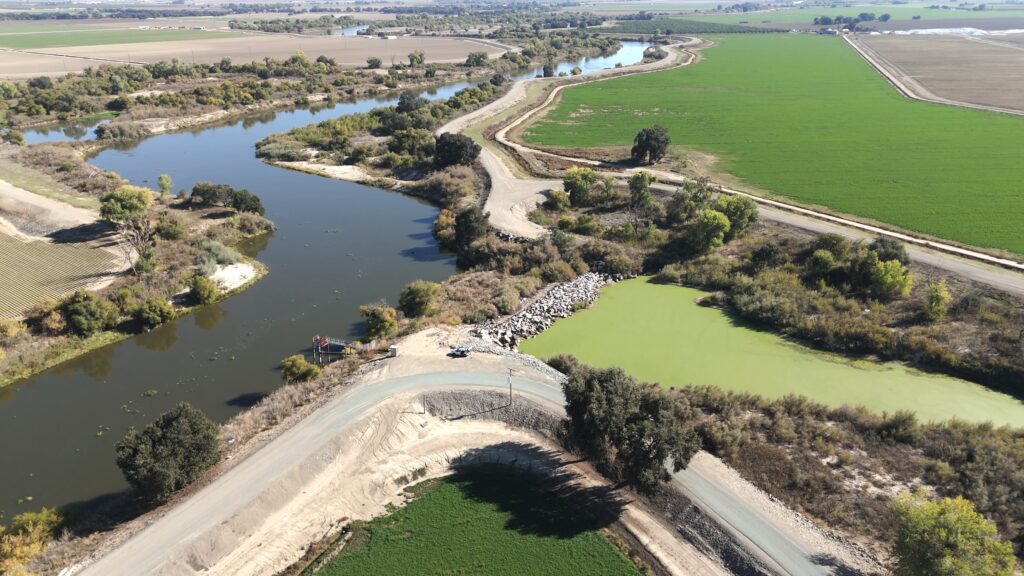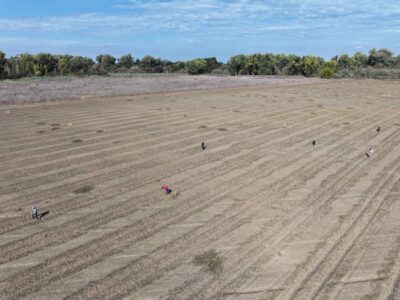It’s a glimpse back at what the Central Valley resembled hundreds of years ago, with a vast landscape of marshes, sprawling grasslands, and immense freshwater lakes. Dense riparian forests lined the San Joaquin River and supported diverse ecosystems and abundant wildlife, some of which were found nowhere else on the planet.
Led by American Rivers, River Partners and California State Parks have embarked on revitalizing the 2,826-acre Great Valley Grasslands State Park, located along the San Joaquin River in Merced County. This effort will open up habitat ideal for juvenile Chinook salmon rearing in the San Joaquin River and add to the largest contiguous block of wetlands in California. Key project partners also include local Tribal communities, like the Northern Valley Yokuts and Amah Mutsun Band.
Beginning in October, we began strategically punching holes into and removing sections of an old and unused levee system with the goal of restoring a long-disconnected section of the San Joaquin River’s floodplain. After the levee breaches are complete, American Rivers Associate Director of California Conservation Kristan Culbert said she will be relieved to see the San Joaquin River rise to flood the restored area.
“As restorationists, we get to help the river remember where it used to flow while creating healthier homes for wildlife, birds, and fish,” Culbert said. “I’m also eager for nearby community members to have access to a beautiful park on the San Joaquin River where they can enjoy nature and gather with their loved ones.”
Supported by funding from the California Department of Fish and Wildlife’s Proposition 1 Watershed Restoration Grant Program, Cox Enterprises’ Water Neutrality Program, and State Park’s Cannabis Watershed Protection Program, the project represents a major investment in the Valley’s ecological future.

“Great Valley Grasslands State Park is a special part of the wilderness of the Central Valley, and the project is key to maintaining the ‘wild,’ so that plants, animals, and humans alike can continue to thrive and enjoy the park,” said Paige Haller, California State Parks Sector Manager of the Central Valley.
Great Valley Grasslands State Park remains one of the last intact remnants of 227 acres that supported a rich mix of native plants and wildlife, including endangered Chinook salmon, fairy shrimp, and Delta button celery. It offers a rare glimpse into the Central Valley’s pre-settlement landscape.
“It’s one of the best examples we’ve got of what it used to look like,” said River Partners Senior Restoration Science Ecologist Mike Davis. “It’s like a time machine.”
Once the largest network of wetlands and riparian forests in California, the Central Valley’s floodplains were drastically reshaped over the past century by levees, dams, and development. A levee built in the mid-1950s cut the park’s floodplain off from the San Joaquin River, creating and protecting farmland, while also disconnecting floodplains from the rivers of the Central Valley.
The result over time was predictable—loss of native species, overgrowth of invasive plants, a drop in connections that sustained salmon runs, and declining ecological health and species biodiversity. By the early 1980s, the levee was deemed useless yet remained and continued to prevent flows from spreading out from the San Joaquin River across its historic floodplain without providing flood protection or any other function.
Now, River Partners and partners are taking a different approach to restore balance. Using heavy equipment, crews are cutting strategic gaps in the levee so that when the rivers flows increase with seasonal changes, floodwaters can once again spread slowly and naturally across the land.

Heather Reith, California State Parks Natural Resources Program Manager for the Central Valley District, noted that a restored floodplain would increase flood safety, while reducing erosion occurring within the park and the cost and ecological impacts associated with continued levee maintenance.
“This project could serve as a model for multi-benefit flood management projects to be replicated elsewhere in the San Joaquin basin to recover declining species, reduce flood risk liabilities, and increase reliance under a changing climate,” Reith said.
It’s restoration through subtraction: letting the river do what it naturally does best to the benefit of the Central Valley’s precious flora and fauna. Beyond ecological benefits, a restored Great Valley Grasslands will offer improved access to recreation, education, and connection with nature in one of California’s most park-starved regions.
This effort also underscores renewing cultural relationships with the land. Local Tribal communities are bringing traditional stewardship practices, like cultural burning, to maintain a healthier and more resilient landscape. Prescribed burns have already proven effective at removing invasive thatch and giving native species the light and space they need to thrive.
And found nowhere else in western North America is alkali sacaton, a resilient native bunchgrass found nowhere else in western North America, that’s now being cultivated across the state, including by Heritage Growers, River Partners’ nonprofit native seed and plant venture. This grass is extremely adaptable, can tolerate, and thrives in areas with seasonal flooding, drought, and heat.

Once construction is complete at the end of this year, the project team will monitor the restored area to track key indicators of success, like the return of native plant species, increased use of the area by wildlife, and abundance of microscopic zooplankton, a key food source for juvenile Chinook salmon, which will once again be able to access the floodplain. These indicators will help guide future restoration projects throughout the San Joaquin Valley, ensuring each effort builds on the lessons learned at Great Valley Grasslands.
Culbert said seeing her team explore new public-private partnerships to support work like this has been exciting and presents an excellent model of how integrated floodplain management-focused projects can be successfully implemented throughout California’s Central Valley and the rest of our country. It gives her hope for our shared future.
“Our restoration work at Great Valley Grasslands State Park has been an exciting opportunity to strengthen existing partnerships with State Parks, River Partners, Cox Enterprises, and many others,” she said. “This work has been enriched by the creativity and expertise of our project team, which includes experts in biology, hydrology, engineering, compliance permitting, archaeology, and traditional ecological knowledge.”
Restoring Great Valley Grasslands alongside partners like American Rivers is showing that sometimes the best way forward is to remove what stands in nature’s way.
By breaching levees and restoring floodplains, River Partners is proving that addition by subtraction can bring life back to California’s rivers. Through science, partnership, and a shared vision for the future, this “time machine” landscape is becoming more than a glimpse into history—it’s a blueprint for what restoration can achieve across the Central Valley.
“This project represents a landmark opportunity to heal a vital piece of California’s natural hydrology,” said River Partners President Julie Rentner. “By restoring this crucial connection, we’re creating over 200 acres of essential habitat for endangered salmon and adding to the largest contiguous block of wetlands in California. This is the future of river restoration.”








